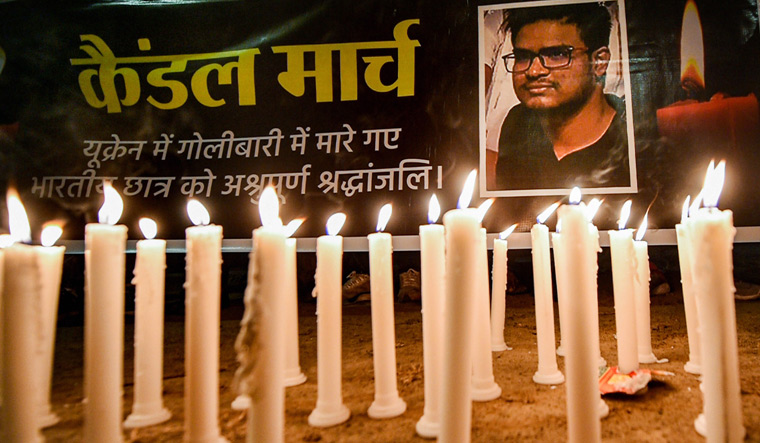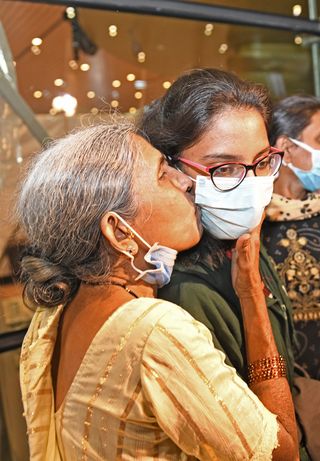At around 7.30am on February 24, a decorative glass object toppled to the floor of Siddharth Saini’s studio apartment. And he knew the nightmare had begun.
A deafening roar filled the street outside; it was the 22-year-old Haryanvi’s introduction to bombs. A fourth-year student at Vinnytsia National Pirogov Memorial Medical University in Ukraine, Saini had somehow managed to get a ticket back to India via Dubai for the 24th evening. He was due to take a train in an hour to reach Kyiv. Incidentally, the war was declared that morning. However, something bizarre happened then. “At 8:45am, our online classes began. I did not understand… the country is under war, and they are taking online classes?” asked Saini, as he waits in a Romanian shelter for a bus to Bucharest—and from there, a flight to India.
Saini said that Ukrainians were anticipating something “very big” from Russia since December. His friends from other countries like Sweden had left Vinnytsia when US President Joe Biden sounded the alarm in the second week of February. But the Indian embassy was not quite panicking yet. And, in the city, everything was going on as usual. Saini, however, started looking for flight tickets from February 17 onwards. His bookings would get cancelled, or the prices would hit the roof. While a one-way ticket from Kyiv to Delhi would normally cost Rs20,000-Rs22,000, from the middle of February, it started hovering between Rs70,000 to Rs80,000. When Russian President Vladimir Putin officially recognised the independence of the two separatist regions in eastern Ukraine, Saini ignored the cost and booked tickets for the 24th. However, he dropped his plans when friends from Kharkiv National Medical University were not allowed to deboard their bus at Kyiv airport, as all the flights were cancelled. They alerted Saini to stay put in Vinnytsia.
Also read
- Battlefield or football field? Arsenal's Oleksandr Zinchenko has no doubt
- CBI busts trafficking racket sending Indians to Russian warfronts, 7 cities including Delhi witness raids: Report
- Indian national forced to fight for Russia in Ukraine war killed; deceased hailed from Hyderabad
- Leaked German military recording: With new Spy vs Spy game, has Cold War begun again?
- Two years of Ukraine-Russia war: Can Kyiv sustain the fight against the Kremlin?
- President Zelenskyy may be sensing a potential political rival in General Zaluzhnyi
“Those sirens started going off—the sirens to prepare your emergency backpack and head to the bunkers below. They would haunt me for the rest of my life,” recalled Saini about the three chilly nights he spent in a bunker. “Three short sirens mean it is safe to get out. One long siren is to drop everything and head to the bunkers with your emergency kit. Three long sirens means to drop everything and leave right away for the bunkers. Even without your documents!”
On February 26, Saini and his group of friends got a bus to the Romanian border, where he was not prepared for the long line of Ukrainian cars waiting to cross over. “We walked for some 7km with our luggage, documents, six litres of water, laptops and food,” he said. “When we got to the checkpoint, the scenes of manhandling we saw, it is best to not describe them. The authorities were bashing women.” Saini waited in queue for a day in freezing temperatures to cross the Romanian border.
According to the Ukraine ministry of education and science, there are 20,000 Indians in the country, of which 18,000 are students. Most of them are medical students as it is cheaper to study medicine there than in private Indian medical colleges. It is also a gateway to working and settling in Europe. But what happens now for the many Indian medical aspirants when the battle is lost and won, and a post-war Ukraine undertakes the arduous journey of repairing a ravaged economy and a deeply wounded society? “Only those students in their third, fourth or fifth year will come back to complete their degrees,” said Raj Pandey, a fifth-year student at Bogomolets National Medical University in Kyiv. He left for India in the middle of February itself under intense family pressure. “Medicine is a practice-based profession. The last two years have been the worst possible time for Indian medical students in Ukraine. First, there was Covid and now this war,” said Pandey, who is now tapping into his local contacts in Ukraine to arrange buses and cars for trapped students in Kharkiv.
Janani is a student at Kharkiv National Medical University. On February 28, she responded to Telegram messages from her university bunker—where she had been trapped for five days with 80 other Indian students. “If we want to leave, we should go at our risk. The Indian embassy is not taking any steps for us,” she wrote at 6:42pm. When asked about her escape plans, she said: “The Indian embassy should help us to get out. We do not want to take any risk.” Can you still hear bombings? “Yes, we heard that sound.” That was Janani’s last message at 6:50pm. And then radio silence.
Shilpa Gupta, a student from Bihar, studying at the International European University in Kyiv, managed to reach the Warsaw airport in Poland on February 28 for a flight back to India via Doha. But she is hardly relieved. “I bought my tickets. There was no arrangement of any flight, no camping, no Indian embassy number was working. I am all alone in this situation,” she said in a voice note.
Debanani Guha in Kolkata is waiting for her son Suvonil to return. She is not exactly stressed; her son is waiting for his turn to board a flight in Romania. The worst is over. “Their agent has helped them a lot,” she said. “Once they crossed the border, they got blankets and food from the Romanian people. Embassy instructions were always very vague.”
Suvonil, 23, managed to get across the border by flexing his good old Indian jugaad skills. “I got into a line which had many Nigerians and several contractors. They somehow managed to push their way through,” said Suvonil. He knows the situation is much worse for thousands of others still trying to leave Ukraine. “Yes, we are worried for our future, but we hope the situation gets better in Ukraine in the coming days,” he said. “I do not know if I can work there anymore, but I just want my medical degree at this point.”



